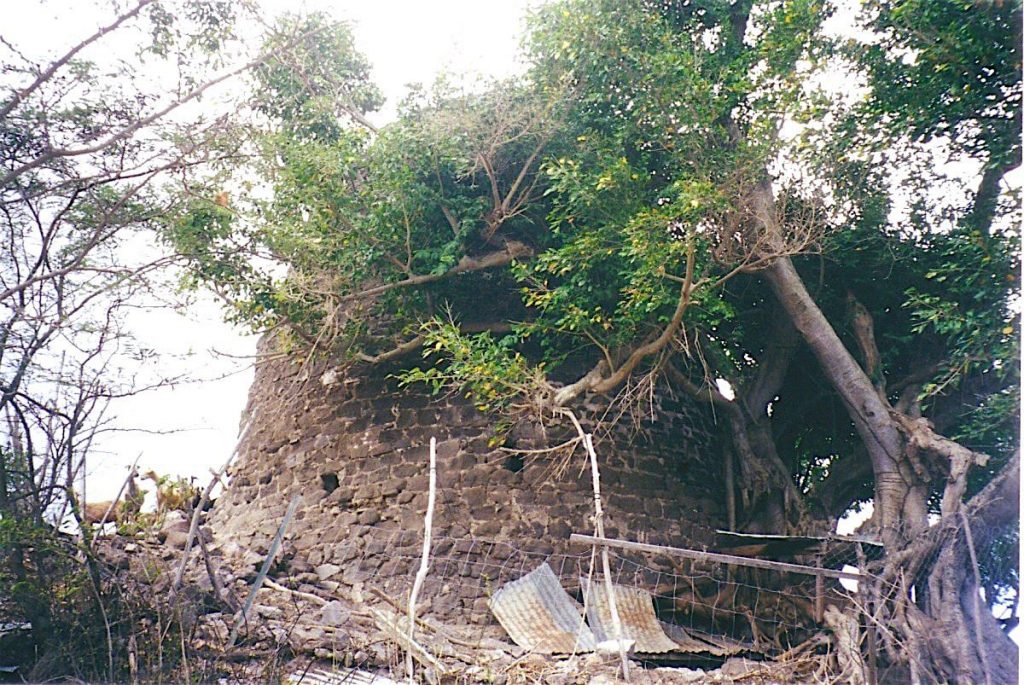About
Type: Ruin
Parish: St.Mary
Founding date: 1740
Long, lat: -61.23499, 17.045153

Current Status
The mill is built of very dark stone and is crumbling. It is now used as a goat pen and was built of a very dark volcanic stone, probably from the surrounding area, which was the norm for most of the mills in Antigua.
Estate Related History/Timeline
“Thomas Sawcolt petitions for 10 acres granted to Mr. John Ducoster, bounded S by land formerly Mr. Richard Cheshires, E with Widow Byam formerly Walronds, N with Mr. Elliott, W with Mr. Preston.” History of the Island of Antigua by Vere Oliver Vol.III
1746: Will. Col. John Sawcolt of “Sawcolts Road” in St. Mary’s and “Sawcolts Body” in St. John’s. His 6 daughters inherited his estates. “Sawcolts Road – e. by Messrs Dean & Adney, S. by Lockhart Russell & John Gilchrist and W. & N. by George Byam. “Sawcolts Body” E. by Thos. Warner & Daniel Mathew, N. by Thomas Warner, W. by heirs of Rowland Oliver dec. and S. by Daniel Mathew formerly the estate of John Sawcolt dec…..” Vere Oliver Vol.III P.71
1748: “John Sawcolt, Esq., died seized of the Road estate and by his will dated 31 Dec. 1748 gave all of his estates real and personal to his six daughters… equally. Sawcolts and The Body plantation rented for 900 pounds a year, and The Body was underlet at 120 pounds per year.” Vere Oliver Vol.II p.84 (need to locate “Sawcolts Body plantation)
1759: “Mary Ann Sawcolt, spinster. Will dated 13 Sep. 1759. To my nephew John Burton, a mulatto of 50c pounds. To my nephew John Horsford 10c pounds for a ring …. etc.” “John Sawcolt of “Sawcolt’s Road” Plantation in St. Mary’s and “Sawcolt’s Body” Plantation in St. John’s Division. Capt. of Militia, 1706, Member of Assembly 1712. bur. 2 Jan. 1748 at St. John’s. Will dated 30 Nov. 1746. His six daughters inherited his estates.” Vere Oliver Vol.III P.71
1829: acreage unknown—103 slaves. Owned by James Gilchrist
Sage Hill
1829: Consisted of 333 acres—178 slaves. Owned by Mary Russell.
1878: Almanac shows Sawcolt’s 235 acres belonging to the Water Commissioners.
1941: Antigua Sugar Factory Ltd Cane Returns for 1941 Crop. Sawcolts & Sage Hill. Estimated 500 tons, – acres estate, – acres peasants on the estate, tons of cane delivered 755.
1783: “Letter dated 15 July from Edward Horne, Esq., with his petition to Lord North reciting that he attained the age of 21 4 December 1771, and soon after from extravagance dissipated his property and in August 1722 had to sell his reversion of one-tenth of Sawcolts, to which he was to succeed after his mother’s death. John Horsford was the lessee of the estate, and his lease would expire in 1783, he being the petitioner’s first cousin, who offered 300 pounds for his one-tenth share………. Petitioner, having lived some years with Thomas Warner, the Attorney-General, was admitted in 1778 to practice law and brought a chancery suit v. Horseford in 1782. The estate was worth 15,000 pounds, and his one-tenth was worth 1,500 pounds. Petitioner lost his case and now appeals against Horseford, who took advantage of his youth and inexperience to defraud him.” Vere Oliver Vol.II p.84
Brother John Taylor, pastor at Grace Hill Moravian Church. Moravian Archives Bethelhorn, PA.
1820: “…. thence to Sawcolts, when the manager at noon ordered the boiling-house cleared for the people to assemble.”
1829: In 1829, this Estate contained 234 acres – 72 slaves.
1852: In 1852, it consisted of 234 acres and was owned by Robert Horsford. 1820’s Hon. Paul Horsford, Attorney General for the Leeward Islands. Horsford Hill still retains the name of this family as you approach Falmouth. 2016.
1864: “The daily yield of water from the three principal springs, all situated about six miles from St. John’s, was measured during a period of drought. The water from these springs was collected and carried by pipes to a large reservoir situated at Barnes Hill to the southwest of St. John’s, where it has been distributed all over the city.
Sawcolts – 12,960 gals.
Mill Hill – 20,160 gals.
Breaknocks – 8,640 gals.” Vere Oliver Vol.I p.clvi
Legacies of British Slave-ownership claimants: In 1833, Parliament finally abolished slavery in the British Caribbean, Mauritius, and the Cape. The slave trade had been abolished in 1807, but it took another 26 years to effect the emancipation of the enslaved. The legislation of 1833 was the result of a combination of factors where it was felt that the plantation owners should be compensated for their slaves who were to be freed. The amount of 20 million pounds, a huge amount in those days, was divided between all slave owners. John Athill – absentee/resident? George Horsford, and Samuel Nelson – awardee. Unsuccessful were John Horsford and Paul Horsford. Antigua 285/752/756 (Sawcolts) view 767 943 11s 9d (71 enslaved). view 375 13 0s 9d.(1 enslaved) view 378 42 8s 6d. (4 enslaved).
Enslaved People’s History
Based on contemporary research, we have little information to share about the enslaved peoples from this plantation at this time. We do know that, together, Sawcolts and Sage Hill had 280 enslaved peoples right before the abolition of slavery in England. We will continue our quest for more information about these vital individuals.
Ownership Chronology
- Ownership prior to Thomas Sawcolt
- 1740: Col. John Sawcolt. d.1746
- 1748: Heirs of John Sawcolt- son-in-law George Horsford purchased all shares.
- 1750: George Horsford, md. 1740 to Henrietta Sawcolt.
- 1790: John Horsford. Will sworn 1795.
- 1829: Messrs Hyndman. 72 slaves. (might have been leased as it remained in the Horsford name)
- 1843: Paul Horsford. d.1850
- 1852: Robert Horsford, Sir. b.1798 d.1875. 234 acres. 1846 Horsford Almanac
- 1871: The Water Commissioners. 235 acres. 1872 Horsford Almanac
- 1930: Land Settlement Government 1933 Camacho map
- 1991: The Water Commissioners. (Water Works Co.)